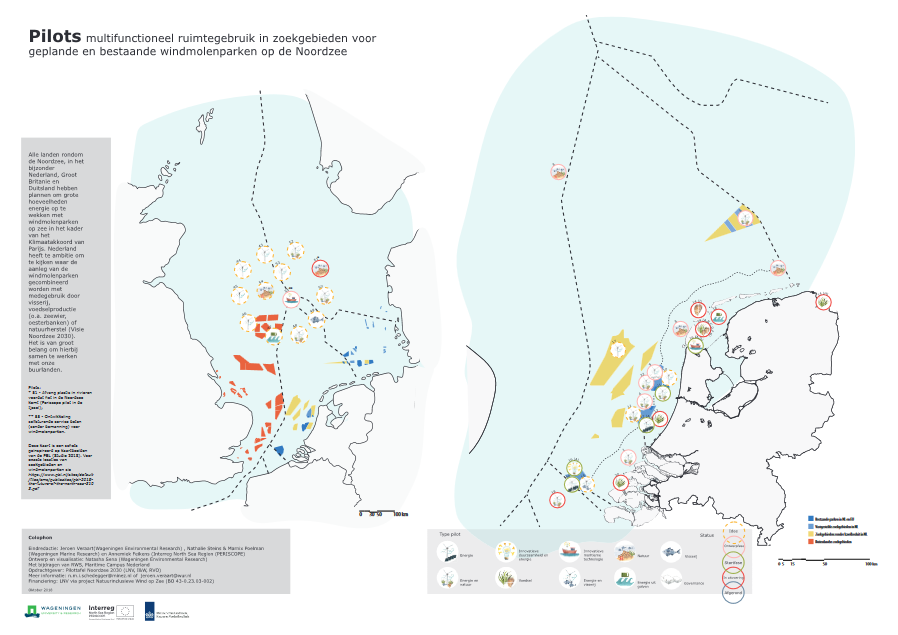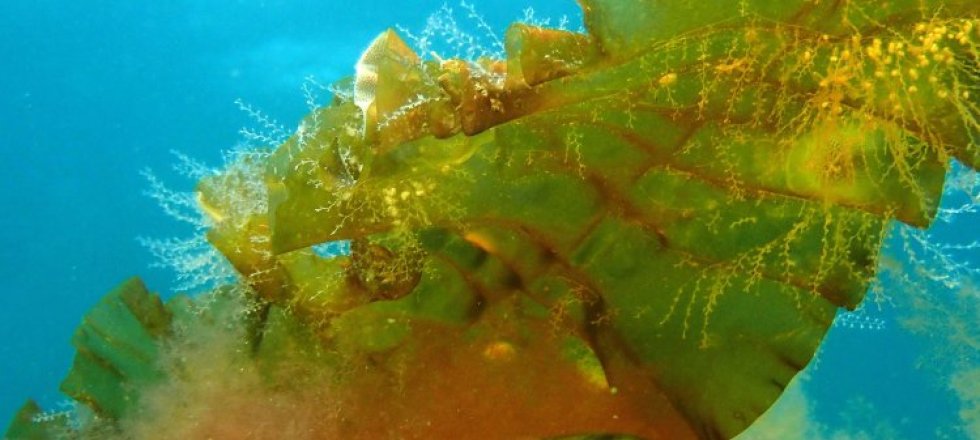Offshore wind energy: Opportunities for aquaculture and passive gear fisheries
The large-scale expansion of wind energy in the North Sea will lead to a substantial claim on space. This impacts the North Sea's efficacy as a food source and thus affects the role the North Sea plays within the framework of food security for an increasing world population. On the one hand, the construction of wind farms will hamper trawler fishing, which means this sector must seek alternative fishing grounds or methods. On the other hand, the wind farms will create new opportunities for the development of aquaculture (i.e. shellfish and seaweed farming), and new or adapted fishing techniques (multifunctional use).
The developments towards a new Blue Economy are still underway, which offers the best possible opportunities for the design of integrated wind farms that include production, nature-inclusivity, circularity (resources and nutrients) and climate resilience.
European Union Blue Growth-strategy
The EU strategically focuses on 'Blue Growth' to galvanise the economic change and the European competitive edge through innovations in the marine and maritime sector. Innovations in marine food production are a crucial aspect of this strategy.
Wind farms have been planned in several locations on the Dutch Continental Plate (DCP). Other sites are sought as well. It is increasingly important that these zones are available for multi-use.
Wageningen Marine Research maps:
- Where specific methods of food production are more, or less, successful;
- Which processes within the ecosystem may be used to this end;
- Which services and impact may be expected;
- How the different combinations may best contribute to a resilient system for the future from an ecological (land-water-atmosphere) and production perspective.
Pilot projects in seaweed cultivation and oyster farming are already underway in several areas, indicated on the map below.

Seaweed cultivation
Seaweed seemingly offers endless possibilities. It serves as a novel ingredient on our menu, a 'secret ingredient' in livestock and fish feed, a source of health supplements, or a sustainable feedstock for bioplastics and fuel. Businesses and governments seize the opportunities wind farms offer to cultivate seaweed and algae. The North Sea Regional Agenda 2050 even includes 400 square kilometres in sustainable seaweed farming.
Read more
What opportunities do wind farms offer for seaweed cultivation?
Wageningen University & Research and the North Sea Farm Foundation (Stichting Noordzeeboerderij) are currently working on a wide range of related research projects with the first 17 partners from the seaweed sector.
Wageningen Marine Research studies:
- The ecological risks of and opportunities for seaweed cultivation;
- Which locations are suitable for the cultivation of seaweed, and with what varieties and combinations thereof;
- Technological innovations in monitoring production and ecological effects;
- Development of knowledge about ecosystems services that may lead to increased yield.
Contact our expert
Lobster and edible crab
Preliminary research shows that pot and trap fisheries for lobster and edible crab offer a viable business model.
Wageningen Marine Research collaborates with Wageningen Economic Research and a fisheries cluster made up of Cramer Noordwijk Beheer BV (Rems Cramer), Noordzee Charters (Arjan Korving) and Rederij W. van der Zwan & Zn BV within the Win-Wind-consortium (funded by TKI Wind op Zee). This consortium studies the possibilities with regard to lobster and crab fishing around offshore wind farms.
Read more
How to make lobsters and crabs profitable?
In the WIN-WIND project, we study:
- The ecologies of the lobster and edible crab around wind farms in the North Sea
- The market potential these lobsters and crabs have, and whether a sustainability label can be achieved
- Low-risk lobster and edible crab fishing methods
- The creation of a framework for dialogue and collaboration between offshore wind farm operators, government, knowledge institutes and fishers.
Contact our expert
Mussels and oysters
Research indicates that shellfish farming could be a profitable business model for offshore wind farms.
Read more
Longline mussel farming
1000 kilos of oysters and testing cages
In the Gemini Wind Farm north of Schiermonnikoog, 1000 oysters and experimental cages have been deployed in collaboration with the Flat Oyster Consortium (Platte Oesterconsortium, POC). This is a first attempt at creating an oyster bed in a wind farm. In wind farm Luchterduinen, experiments with flat oysters are underway. Until the start of the 20th century, some 20% of the North Sea bed was covered in oyster beds. However, these beds have all but disappeared due to overfishing, disease and climate change. We hope to stimulate the recovery of nature by reintroducing oysters and creating opportunities for oyster farming.
The preliminary results are encouraging. The oysters are procreating, and biodiversity is on the rise and research on keeping the local oysters healthy appears promising. Oyster reefs also provide shelter for other species such as lobsters and crabs that can also be fished.
Contact our expert
Non-trawl fisheries
Together with the fishing industry and stakeholders, Wageningen Marine Research is working on alternatives to bottom trawling in wind farms.
Read more
Can the loss of fishing grounds be compensated?
Bottom trawling, such as fishing for flatfish, is not permitted in wind farms due to the possibility of damage to wind turbines and cables.
To compensate for the loss of fishing grounds, Wageningen Marine Research is conducting research on which fish species are found in wind farms and which fishing techniques would be suitable, such as longline or set gillnet fishing.
